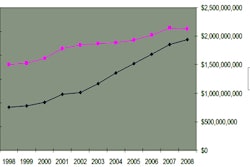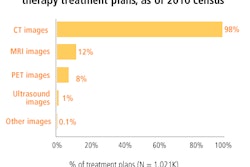SAN FRANCISCO - Researchers suggest that radiation exposure to the heart and spine can be reduced by using intensity-modulated radiation therapy (IMRT) as opposed to 3D conformal radiation therapy (3DCRT) when treating patients with distal esophageal cancer.
However, the use of IMRT appears to increase radiation exposure to the lungs and liver, said Sachin Patil, MD, a resident in radiation oncology at Roswell Park Cancer Institute in Buffalo, NY.
"When optimized for the heart, IMRT is superior in these patients," Patil said at his poster presentation at this week's Gastrointestinal Cancers Symposium. "Further evaluation using IMRT optimized for the lung is indicated."
In the study, Patil and colleagues evaluated eight patients (seven men and one woman) with node-negative cancer of the distal esophagus. The cancers ranged in size from 1-3 cm, and target volumes were generated for all patients based on standard current practice. The median age of the patients was 71.5 years.
The researchers created 3DCRT and IMRT plans optimized to provide minimum dose to the heart using a commercially available treatment planning system (Eclipse, Varian Medical Systems, Palo Alto, CA). Conformality index and conformation number were calculated, according to Patil. Dose-volume histograms also were generated and clinically relevant parameters were extracted and compared for each planning modality using paired t-tests. Each patient served as his or her own control.
Using IMRT, a mean conformation number of 0.74 was achieved, compared with a mean conformation number of 0.45 for 3DCRT (p < 0.0001), Patil said.
When looking specifically at the spinal cord, the radiation exposure using 3DCRT was calculated to be 43 Gy, compared with 24.9 Gy for IMRT (p = 0.0005). The radiation exposure to the heart using 3DCRT was 30.2 Gy, compared with 24.6 Gy using IMRT (p = 0.0136).
However, Patil also noted that the mean lung radiation dose was 6.7 Gy using 3DCRT and 9.4 Gy using IMRT (p = 0.0054). The mean radiation dose to the liver using 3DCRT was 10.5 Gy, compared with 13.5 Gy for IMRT (p = 0.0034). There was no statistically significant difference in radiation exposure for the stomach, at 31 Gy with 3DCRT and 29.6 Gy for IMRT (p = 0.3657).
The Gastrointestinal Cancers Symposium is cosponsored by the American Gastroenterological Association (AGA), American Society of Clinical Oncology (ASCO), American Society for Radiation Oncology (ASTRO), and Society of Surgical Oncology (SSO).
By Edward Susman
AuntMinnie.com contributing writer
January 22, 2011
Copyright © 2011 AuntMinnie.com



















